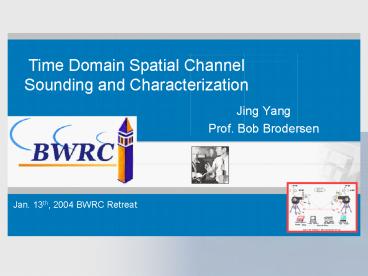Time Domain Spatial Channel Sounding and Characterization - PowerPoint PPT Presentation
1 / 10
Title:
Time Domain Spatial Channel Sounding and Characterization
Description:
TX Angle = 0, RX Rotates 360o in Azimuth. Radiation Patterns at Different Times ... TX Azimuth and Elevation - RX Azimuth and Elevation (the same amount of ... – PowerPoint PPT presentation
Number of Views:69
Avg rating:3.0/5.0
Title: Time Domain Spatial Channel Sounding and Characterization
1
Time Domain Spatial Channel Sounding and
Characterization
Time Domain Spatial Channel Sounding and
Characterization
- Jing Yang
- Prof. Bob Brodersen
Jan. 13th, 2004 BWRC Retreat
2
Project Goal
- Goal System Specification for
Cognitive Radio - Procedures
- Other Applications
- DSP Algorithms SVD Algorithm
- 60 GHz Phased Array Analysis
1
wideband channel characterization
2
3
Parameters
Channel Model
- Sensitivity Requirement
- Fading
- ADC
- Noise Figure
- Beamforming
- Spatial
- Frequency
- Time-variation
- Interference
- High-level Analysis
- Emulation
3
Approach
- Whole System Characterization
- Sounding pulse (with front end)
- Transmitter and receiver antennas
- Impulse response of the detector (oscilloscope
and front end) - Interference subtraction
- Deconvolution is needed for the characterization
of wideband channels - The limited bandwidth of available test signals
as compared to the bandwidth of the channels
themselves - Channel Modeling
- Resolving impulse response components into bins
smaller than the duration of the sounding pulse
and smaller than the reciprocal of the channel
bandwidth
4
Measurement Setup
5
Radiation Patterns at Different Times
- Single Antenna Beam (-30o30o)
- Antenna array (two antennas)
- Single antenna beam (-3030)
- Cross Array with Four Antennas, Amplifiers
(25dB) - TX Angle 0, RX Rotates 360o in Azimuth
6
What is special about wideband signals?
- The waveforms radiated in different directions
from the TX antenna - The impulse response at different positions
- look considerably different in the far field
region !!!
Explanation If we calculate the center
frequency wavelength and compare to Antenna
Antenna is electrically large compared to the
wavelength of the center frequency of the
received signal
7
Interference Subtraction
8
Subtractive Deconvolution
- Model the impulse response of the channel as a
summation of effective scatterers - In time domain, we initialize the dirty map with
and clean map with ,
then use the clean pulse to find the peaks in
the dirty map and add them to the clean map - Different ways to clean the dirty map
- Minus it from the dirty map
- Substituted 0 at the detected components
- Assuming multipath components do not overlap
9
Multi-Template Subtractive Deconvolution
- Realization Consideration
- Threshold (Dynamic threshold changing)
- Zero multipath component or minus from dirty map
- Reciprocal of TX and RX not longer hold
- Dimension
- TX Azimuth and Elevation
- - RX Azimuth and Elevation (the same amount of
data 1387) - - Antenna 4 multi-antenna
10
Conclusion and Future Work
- Whole System Characterization
- Sounding pulse (with front end)
- Transmitter and receiver antennas
- Impulse response of the detector (oscilloscope
and front end) - Interference subtraction
- Deconvolution is needed for the characterization
of wideband channels - The limited bandwidth of available test signals
as compared to the bandwidth of the channels
themselves - Channel Modeling
- Resolving impulse response components into bins
smaller than the duration of the sounding pulse
and smaller than the reciprocal of the channel
bandwidth































